
Theatrical Lighting Design And Inventory Management System
User Manual
Table of Contents:
1. Before using the software
2. Diagram Drawing
2A. Adding Objects
I. Adding the House Object
II. Adding the Stage Object
III. Adding the Bar Object
IV. Adding the Instrument Object
V. Adding the Set Object
2B. Removing Objects
I. Removing the House Object
II. Removing the Stage Object
III. Removing the Bar Object
IV. Removing the Instrument Object
V. Removing the Set Object
2C. Modifying Objects
I. Modifying the House Object
II. Modifying the Stage Object
III. Modifying the Bar Object
IV. Modifying the Set Object
V. Aiming an Instrument
2D. Error Checking
3. Viewing/Selecting Objects
3A. Explorer Menu
3B. Interactive Drawing Window
3C. Item Browser
3D. Control Panel
4. Inventory Manager
5. Loading/Saving Designs
5A. Saving a Project
5B. Opening a Project
5C. Opening individual components:
6. Photon Map Rendering
6A. Entering 3D Data
6B. Schematic View
6C. Cue Editor
7.Glossary of Theatrical Terms
1. Before using the software
Before attempting to run the software the user should have a basic knowledge of theatrical terms. A glossary of theatrical terms is provided at the end of this manual for those who are not knowledgeable in this field. In addition, please make sure your computer meets the following performance guidelines before trying to run the software:
128 MB RAM
500MB
750 MHz processor
JAVA installed on computer.
To Install the Theatrical Lighting Design and Inventory Management System Software just Drag&Drop the .jar executable to the folder you would like to keep it in.
To Run the executable double click on it if it is a graphical operating system or if you are using a command line use the java -jar “Executable.jar” command.
2. Diagram Drawing
This section will detail all you need to know about drawing theater objects in the Interactive Drawing Window (labeled below):
2A. Adding Objects
I. Adding the House Object
Note: Adding the house object is necessary for to open a project. It is the space that encloses the theater itself. To add a house to the project execute the following steps:
1. Go to the “File” drop down menu pictured below, and select “New”

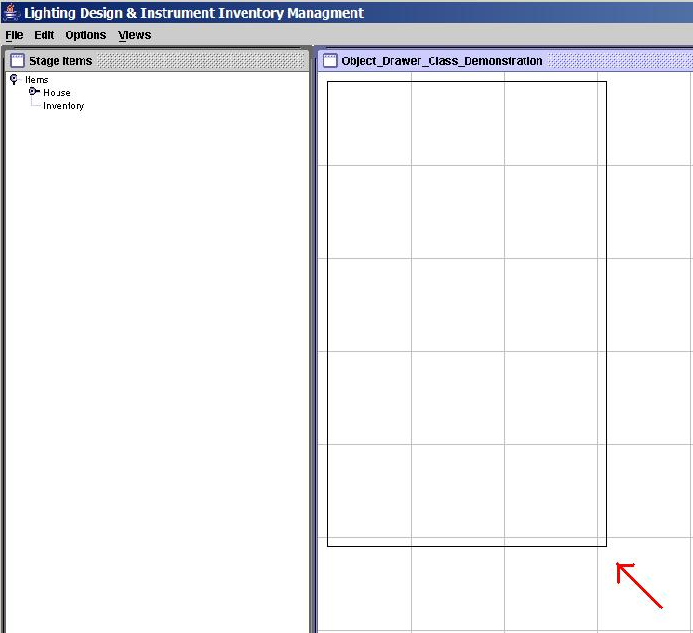
2. The house should then appear.
 II.
Adding the Stage Object
II.
Adding the Stage Object
1. Right click anywhere inside Schematic Drawing Window and select “Add Stage”
2. Left click anywhere inside the house to add up to 15 nodes to represent the stage.

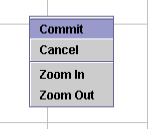
3. Right click on the Schematic Drawing Window again and select “Commit”
III. Adding the Bar Object
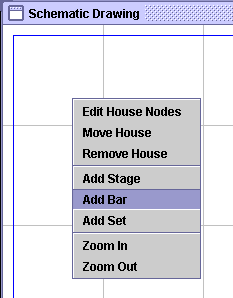 1.
Right click anywhere inside the Schematic Drawing Window and select
“Add Bar”
1.
Right click anywhere inside the Schematic Drawing Window and select
“Add Bar”
2. Left Click inside the house object to add two nodes for the bar

3. Right click in the Schematic Drawing Window again and select “Commit”
IV. Adding the Instrument Object
1. Click the “Views” menu and select “Inventory Management”
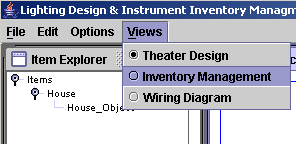
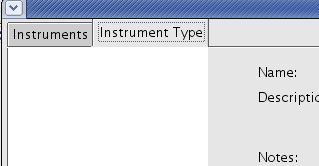 2.
If there is no types available then click on the Inventory Type tab.
Fill in the information for the type and edit the custom look for the
instrument with the node editing buttons.
2.
If there is no types available then click on the Inventory Type tab.
Fill in the information for the type and edit the custom look for the
instrument with the node editing buttons.

3. Type in the object name and description, and select a type from the Type drop down and select “Save”.
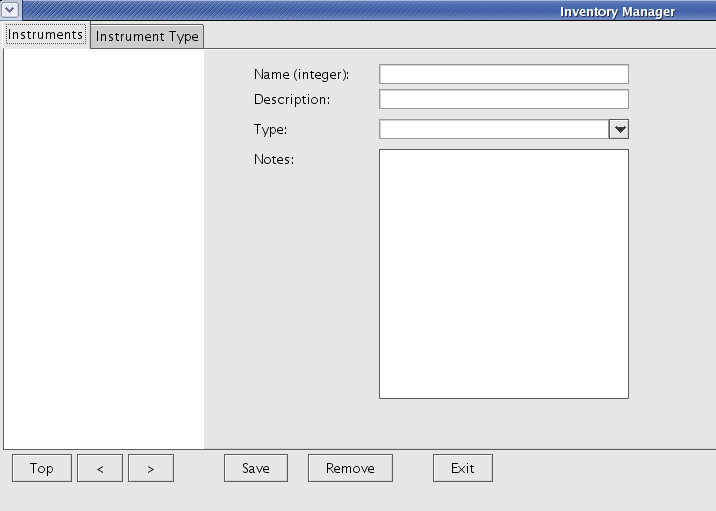
4. Select a bar with the Explorer Browser or by clicking on it in the Schematic Drawing Window.
5. Right Click and select the option “Add Instrument”.

6. Left Click where the instrument is to be placed on the already selected bar.
7. Select the correct instrument from the drop down list of instruments in inventory.
8. The instrument will appear on the bar that is selected.
V. Adding the Set Object
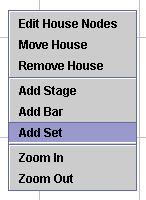 1.
Right click anywhere inside the house and select “Add Set”
1.
Right click anywhere inside the house and select “Add Set”
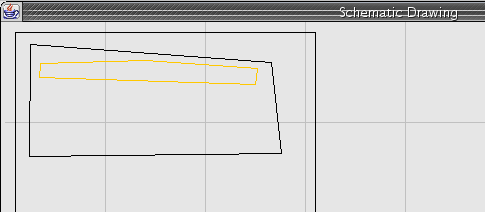 2.
Left click anywhere inside the house object to add up to 15 nodes for
a set object.
2.
Left click anywhere inside the house object to add up to 15 nodes for
a set object.

3. Right click on the house again and select “Commit”
2B. Removing Objects
 I.
Removing the House Object
I.
Removing the House Object
1. When the house is selected Right click on the house and select “Remove House”.
II. Removing the Stage Object
 1.
Select the stage in the Item Explorer window then right click the
house and select “Remove Stage”
1.
Select the stage in the Item Explorer window then right click the
house and select “Remove Stage”

III. Removing the Bar Object
1. Select the bar in the Item Explorer window or the bar that is drawn then right click the house and select “Remove Bar”
IV. Removing the Instrument Object
1. Select the instrument in the Item Explorer window or the instrument that is drawn then right click the house and select “Remove Instrument”
V. Removing the Set Object
1. Select the bar in the Item Explorer window or the bar that is drawn then right click the house and select “Remove Bar”
2C. Modifying Objects
 I.
Modifying the House Object
I.
Modifying the House Object
1. Editing the house nodes: Select the house object from the “Item Explorer”, or by clicking on the drawn object then right click the house and select “Edit House Nodes”
2. You may then select one of the vertices's and click wherever you would want to select it.

3. Right click again on the Schematic Drawing to commit changes.
II. Modifying the Stage Object
1. Select the stage object from the “Item Explorer”, or by clicking on the drawn object then right click in the Schematic Drawing window and select “Edit Stage Nodes”
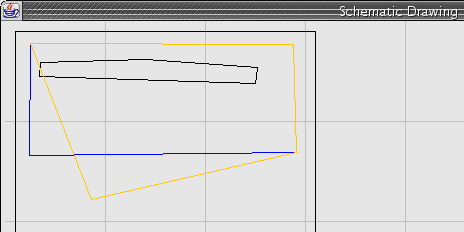
2. You may then select one of the vertices's and click wherever you would want to select it.
3. Right click again on the Schematic Drawing to commit changes.

III. Modifying the Bar Object
 1.
Select the bar object from the “Item Explorer”, or by clicking
on the drawn object then right click in the Schematic Drawing window
and select “Edit Bar Nodes”
1.
Select the bar object from the “Item Explorer”, or by clicking
on the drawn object then right click in the Schematic Drawing window
and select “Edit Bar Nodes”
2. You may then select one of the vertices's and click wherever you would want to select it.

3. Right click again on the Schematic Drawing to commit changes
IV. Modifying the Set Object
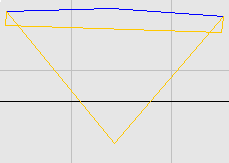
1. Select the set object from the “Item Explorer”, or by clicking on the drawn object then right click in the Schematic Drawing window and select “Edit Set Nodes”
2. You may then select one of the vertices's and click wherever you would want to select it.

3. Right click again on the Schematic Drawing to commit changes.
V. Aiming an Instrument
 1.
Select an instrument in the Explorer Browser or by clicking on it in
the Schematic Drawing Window.
1.
Select an instrument in the Explorer Browser or by clicking on it in
the Schematic Drawing Window.
2. Right click and select the Aim Instrument option.
3. Click anywhere in the Schematic Drawing Window to set the aim point for the instrument.
4. An x will mark the spot and a line will form between the instrument and the x whenever the instrument is selected.
2D. Error Checking
1. If a dialog menu appears saying there was an error processing data and information has been removed it is because an object was affected that was no longer valid for the current schematic drawing.
2. Rules that must be followed for correct creation:
A. All other objects must fully be enclosed by the house object.
B. All instrument objects must be placed on a bar object.
C. All inventory objects must have a valid type associated with it.
D. All objects must be represented by less then 15 nodes except bars which only contains two nodes.
 3.
Viewing/Selecting Objects
3.
Viewing/Selecting Objects
3A. Explorer Menu
If an object is present in the Item Explorer Menu then to select it left click on the name.
If the object is visible in the interactive window it will become highlighted in blue.
Information about the object will appear in the window on the top right.
3B. Interactive Drawing Window
1. To select an object in the Interactive Drawing Window left click on on of the nodes of the object.
2. If the object is not selected on the first try because of other objects close to it click again until it is selected

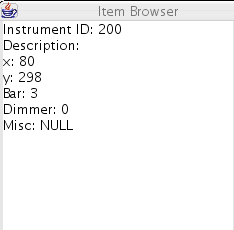 3C.
Item Browser
3C.
Item Browser
1. This window shows information about objects that are selected
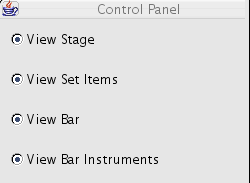 3D.
Control Panel
3D.
Control Panel
1. Radio buttons control what is visible in the Interactive Drawing Window.
2. Clicking on a Radio Button toggles the visibility of all objects of a certain type.
4. Inventory Manager
 1.
Click the “Views” menu and select “Inventory Management”
1.
Click the “Views” menu and select “Inventory Management”
2. The instruments panel displays all of your available instruments in inventory

3. The instrument type panel displays all of your available instruments and has the ability to add and remove types.

5. Loading/Saving Designs
5A. Saving a Project
 Click
the “File” menu then select “Save..”.
Click
the “File” menu then select “Save..”.
Navigate to the director for the files to be saved within.
Type the name of the project file you would like to create.
Files for the project will be created including a file with the same name that was given, and if any objects were present in the project a file for the house, stage, set, instruments, bars, inventory and known types will be created.
 5B.
Opening a Project
5B.
Opening a Project
1. Click the “File” menu then select “Open…”
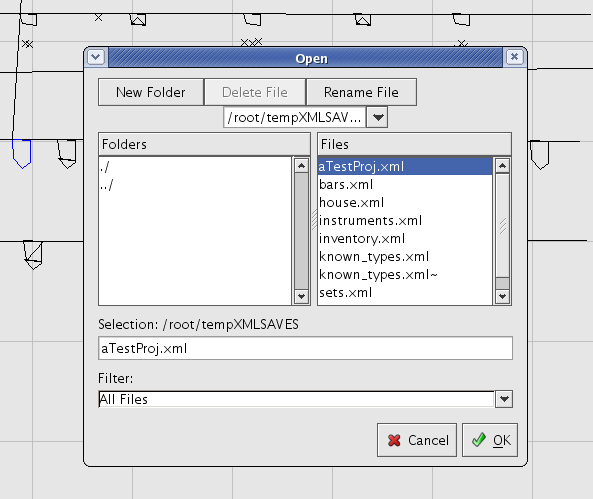
2. When the “Open” dialog is displayed, you can select a file with a name for the project you would like to open.
5C. Opening individual components:
 1.
Click the “File” menu then select “Open…”
1.
Click the “File” menu then select “Open…”
When the “Open” dialog is displayed, you can select a file that is in the same folder as the project that contained the item you want to load.
 Files
are named for what information they contain.
Files
are named for what information they contain.
6. Photon Map Rendering
6A. Entering 3D Data
1. When the stage, set object or instrument is selected right click to bring up the popup menu.
2. Select “Edit <object> Info” from the popup menu
3. Enter in the appropriate information in the text boxes
4. Hit the bottom button Save to commit the data or cancel to not change the original information.
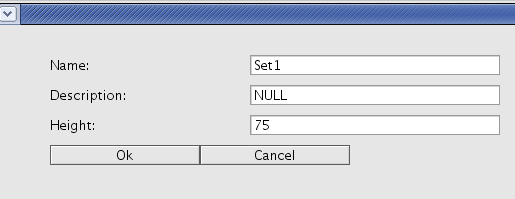
6B. Schematic View
1. Calculate the photon map by selecting the option Render Photons under the file menu
2. Once the photons are rendered select in the Control Pane View Photon Map
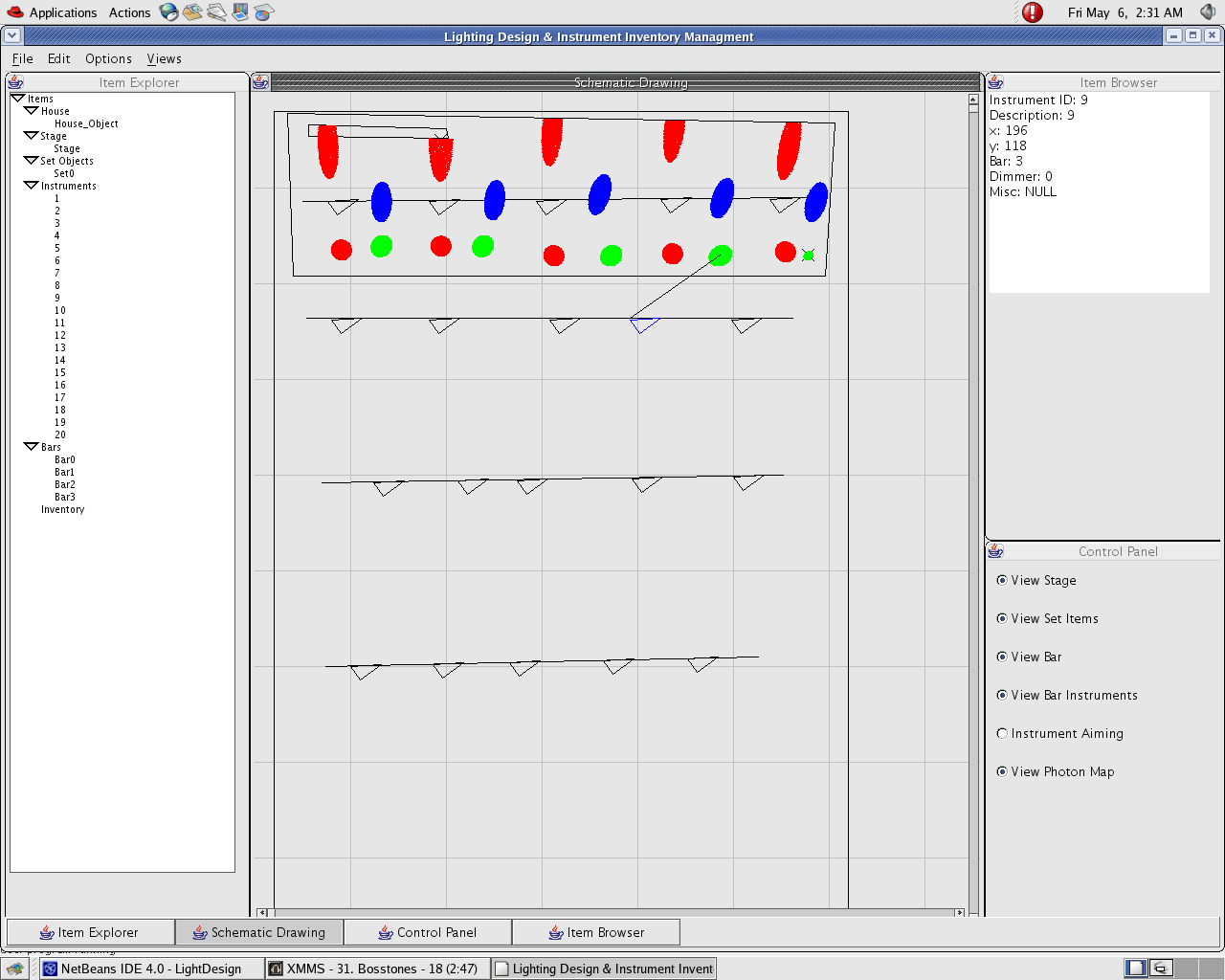
(note: photons have to be rendered again to accurate portray any changes since the previous photon calculations)
6C. Cue Editor
1. Calculate the photon map by selecting the option Render Photons under the file menu.
2. Once the photons have been rendered selct the Cue Editor from the Views Menu
3. After the Cue Editor has loaded all the lights will be set to full power.
4. To control the power level of individual lights move a power slider located at the bottom of the window.
5. To view the changes that have been made click on the render button.

7.Glossary of Theatrical Terms
Types of lighting instruments:
Examples of General names:
Leko
Par
Cyc
Fresnels
Pin Spot
footlights
Striplights
Examples of Specific names:
ETC Source 4 Leko
ETC Source 4 Zoom
ETC Source 4 Jr.
ETC Source 4 Par
ETC Source 4 ParNel
Altman Focusing Cyc
Altman Econo Cyc
Altman 360Q
Par 64
Par 56
Par 46
PAR 38
Par 36 Pin Spot
Par 16 (Birdies)
3" Fresnel (Inky)
6" Fresnel 750w
6" Fresnel, 1000w
8" Fresnel
House - all space that the theater uncompasses.
Stage - were the performance takes place.
Set - all platforms and walls used by actors that are not permanent to the house.
Props - anything used by actors during the performance.
Lighting Bars - Anything that is used to support a lighting instrument. (Bar for short)
Dimmer - A power outlet that a lighting instrument is plugged into.
Lighting Instrument - Anything that is attached to a lighting bar and plugged into a dimmer.
Called Instrument for short or also called fixtures.
Stage left- Normally the left side of an actor on stage looking out at the house.
Stage Right- Normally the right side of an actor looking out at the audience.
House left- Normally the left side of the audience looking at the stage.
House Right- Normally the right side of the audience looking at the stage.
Circuit - number on the lighting board that controls amount of electricity going to a dimmer.
Lighiting Board - Hardware that is used to control lighting instruments.
DMX - A standard communication protocol to control dimmers and instruments.
Acting Area -The area of the stage where the play is performed. Also called the Playing Area.
Apron-In a traditional theater, the part of the stage which projects in front of the curtain. In many theaters this can be extended, sometimes by building out over the pit.
Areas -In lighting design, the divided portions of the stage used to apportion the light.
Arena Stage -A stage in which the audience is seated on all four sides. Also called Theater in the Round.
Auditorium-The part of the theater in which the audience sits. Also known as the House.
Back Drop -A large piece of canvas hung from a batten and painted to represent a particular scenic element. Also called a Drop.
Backstage -The area away for the acting area, including the dressing rooms and the green room. Also called Offstage.
Backing Flat-A flat which stands behind a window or door in the set.
Banjo-Not the musical instrument! A rail along which a curtain runs.
Bar-An aluminum pipe suspended over the stage on which lanterns are hung.
Barn Door-An arrangement of four metal leaves placed in front of the lenses of certain kinds of spotlight to control the shape of the light beam.
Batten -A bar made of wood or steel from which scenery, lights, or curtains may be hung and flown in and out. Also called Pipe.
Beamlight-Lighting term: a type of lantern which produces a parallel beam of light. In construction rather like a car headlamp, being a sealed-beam unit. Also known as a PARCAN or PARBLAZER.
Beam Projector -A type of lighting instrument that has no lens, used to emit a powerful beam of light with diffused light.
Beam Spread-Lighting term: the area that a given lantern covers. It is usually expressed as the angle that the beam subtends at the focal plane: the smaller the angle, the narrower the beam.
Blackout-Lighting term: switching all lights out at once, leaving the stage in complete darkness. See also DBO.
Blacklight-Ultra-violet light. Can be in bulb or, more usually, tube form.
Blacks-Black curtains at the back and sides of the stage.
Board-Another name for a control desk, either lighting (most usually) or sound.
Borders -In scenery, material hung at the top of the set to hide fly system from the audience. Also called Teasers.
Box Set-A set which consists of three walls, around a proscenium arch stage. The proscenium opening is the fourth wall. Also known as a "room set".
Cable -Electrical cord used in circuiting lighting instruments or other stage devices requiring electricity.
Cast-The list of characters in a play and the actors who play them. Also, as a verb, to allocate parts to members of a company.
Catwalk -An immobile platform above the stage that reaches from one end of the stage to the other, used to gain access to the stage equipment.
Center Line -An imaginary or real line that divides the stage area into two equal parts, running from downstage to upstage.
Center Stage -The Middle of the Performance space.
Check-Lighting term: to lower the brightness of a lantern to zero.
Color Changer-A remotely controlled means of changing a colored filter over the lens of a lantern. There are three kinds: a wheel, a semaphore (like the old- fashioned railway signals) and a scroller which uses continuous, usually dichroic, filters. Scrollers are the preferred option in the modern theater.
Color Frame-A frame which fits over the front of a lantern to hold a colored filter or gel. They can be made from metal (preferred) or a kind of cardboard.
Crossfade -A lighting action in which a particular light cue fades down as the next light cue fades up.
CSI-Compact Source Iodide: a type of discharge lamp, usually used in follow-spots, which, although very small (often no bigger than a finger nail), gives a very bright, white light. A 2K CSI lamp will give the same power as a 5K tungsten. These are, needless to say, very expensive.
Counterweight System -A type of rigging that uses weights to counterbalance horizontal battens containing scenery, curtains, or lighting equipment.
Cue -As a verb, the word may be used by the stage manager, who "cues" all technical personnel either verbally or on a light, and "cues" actors by giving them their line when they have forgotten it.
Cue-to-cue -A technical rehearsal that focuses on getting the physical production caught up with the acting by skipping over scenes or dialogue that have no technical cues in them in order to run the next cue.
Curtain -In addition to it's normal definition relating to draperies, a term used to indicate the start or end of a performance such as "Five minutes to curtain" (five minutes to the start of the performance).
Curtain Line -1) The line on the stage floor where the front curtain touches when brought in. 2) The final line in the play. Also called the Tag Line.
Cut-out-A free-standing piece of scenery, e.g. a tree, cut out of board into the correct shape and painted.
Cyc Lights -Type of powerful lighting instruments used to light the cyc with a smooth wash.
Cyclorama-Also known as a cyc. 1) A very large piece of white fabric, tensioned on two or more sides, which covers the entire back wall of the stage. It can be lit in various colors or have slides or gobos projected onto it. 2) A curved drop or wall used as a background to partially enclose the set. Quite often used to depict the sky. May be painted or lit.
DBO-Lighting term. Dead blackout: a sudden, instantaneous switching off of all lights.
Deck -The stage level, derived from ship terminology.
Designer-Designs all aspects of the production: set, costumes, wigs, make-up etc. Not, however, responsible for lighting design, although he will work closely with the Lighting Designer.
Desk-See "Board"
Dim -To decrease the intensity of a stage light.
Dimmer -An electrical apparatus used to control the intensity of the lighting instrument to which it is circuited. Found on the lighting board.
Dips-Electrical socks set into the floor of either the stage or the wings , and, usually, covered by little trapdoors.
Downstage-Towards the audience.
Dressing A Set -The decoration of the set with items that are principally for aesthetic purposes only.
Dry Tech -A technical rehearsal without actors.
DSL-Down stage left: towards the front of the stage on the left-hand side as you look at the audience.
DSR-Down stage right.
Effects Spot-A spotlight which projects a slide, or a still or moving picture, i.e. of rain or clouds, onto the stage or, more usually, the cyclorama.
Electrician -A technician who installs and/or operates the lighting for a production.
Ellipsoidal Reflector Spotlight (ERS) -A type of lighting instrument that emits a hard-edged circle of light. Commonly called a Leko.
False Proscenium -A constructed proscenium that fits inside the permanent proscenium.
Fade-Sound and lighting term: to increase (fade up), decrease (fade down) or eliminate (fade out) gradually the brightness of a lantern or the volume of a sound.
Fill Light -Lights used to illuminate shadowy areas.
First Electric -The first row of lights hung on a batten behind the proscenium.
Flat-An oblong frame of timber, covered with either canvas or hardboard and painted, which forms part of the set. There are also door flats, window flats, even fireplace flats. Canvas flats, being lighter and easier to move around, are the preferred option, but schools often go for hardboard-covered flats which are more durable.
Flood-A floodlight: a lantern which gives a wide-spreading, unfocused beam of light. These can be symmetric (i.e. casting the light equally in all directions) or asymmetric (casting it more in one direction than the others). The symmetric flood is probably the cheapest stage lantern and the least useful!
Floor Pocket -A small iron box containing an electrical outlet, sunk into the stage floor.
Focus-Verb used in lighting: to point the lanterns in the right direction and set the correct beam-spread and edge.
FoH-Front of House: anything which happens on the audience side of the curtain is said to happen "front of house". The term "the house" is used to mean either the auditorium, or the audience ("We had a good house tonight"), or even the theater itself.
Follow-spot-A type of profile spotlight with an iris diaphragm and a handle so that it can be used to follow a performer around the stage in a beam of light of exactly the right size. Traditionally called a "lime": hence the term "being in the limelight". These produce a very bright beam of light which is more powerful than that produced by any other lanterns. Modern limes almost always use CSI lamps.
Footlights-A series of floodlights placed on the stage floor along the front of the stage. Traditional in variety theatres, foots are nowadays rarely used.
Fresnel-A kind of spotlight in which the light is concentrated by a fresnel lens (a lens with concentric ridged rings). Projects a variable angle soft-edged beam. Sometimes called a fr?l and given the French pronunciation.
Front Elevation -A scale drawing that gives a front view of the set.
FX-Effects: usually sound effects in the theater but can also refer to pyrotechnics . In film, usually refers to visual (i.e. computer generated) effects.
G-clamp-Used for fastening lanterns to a bar. A G-shaped piece of metal with a screw through the bar of the G which clamps to the lighting bar.
Gate-The focal plane of a profile spot into which gobos and iris diaphragms can be placed.
Gel-A filter placed over the front of a lantern to change the color of the light.
Ghost Light -A light left on when the theater is locked up for the night.
Gobo-A piece of metal or glass, which fits into the gate of a profile spot and projects a pattern onto the set. Gobos can be very complex. They are first fitted into a gobo holder. Holders vary in size (each type of lantern requires a different size), although the gobos themselves are of a standard size. Most basic gobos are made of metal but very complex patterns can be created on glass gobos. Also called Template.
Grid -A steel framework above the stage from which the fly system is rigged.
Ground Plan -A scale diagram that shows where the scenery is placed on the stage floor. Also called Floor Plan.
Groundrow-1) A batten placed on the floor of the stage, usually to light a cyclorama . 2) Occasionally used to mean freestanding scenery, of a low height, running along the back of the stage in front of the back wall or cyclorama.
Hand Props -Properties that are handled by actors during the performance.
Hand-off -The action of a crew member handling a prop for an actor at a designated time and place during a performance.
Hanging -The process of putting a lighting instrument in its designated spot according to the light plot.
Hot Spot -The area of the greatest illumination projected by a lighting instrument.
House -The part of the theater where the audience sits. See also FoH.
House Lights -Lights used to illuminate the area where the audience sits.
Instrument -A term for lantern, or any lighting device. What in domestic terms we mean by the word "light".
Instrument Schedule -A list of the types of lighting instruments to be used in a show. Also called a Hookup Sheet or Lighting Plot.
Ladders-High stands for hanging lanterns at the side of the stage. Not for climbing!
Lamp -The part of a lighting instrument that emits the light; the "light bulb" of the instrument.
Lantern-What in normal English we call a light, in the theater is called a lantern. Actually, it's a slightly old-fashioned expression: instrument is used more often nowadays.
Left-Stage left, or the LHS as you face the audience. Also called the Prompt Side or PS.
Leko -A type of lighting instrument that emits a hard-edged circle of light. Known by it's brand name. Usually called an Ellipsoidal Reflector Spotlight (ERS) or Profile Spot.
Light Board -The console that controls all the lighting instruments. Also called the Dimmer Board.
Light Plot -A drawn-up plan that designated the placement of lighting instruments relative to the set.
Lighting Designer-Responsible for designing, focusing and plotting the lighting for a production. In the professional theater he is not normally responsible for operating the lighting, although he will usually do that in the amateur theater. Responsible to the Director, not the Stage Manager. Works in close co-operation with the Designer .
Lighting Tree -A vertical pipe that is placed on the side of the stage to hold lighting instruments. Also called Boom.
Lime-See Follow Spot
LX-Electrics. The title is given to the lighting department, and the Chief Electrician is known as the Chief LX.
Masking -To hide any stage equipment or offstage area through the use of curtains, flats, etc.
Multiplex-A means of sending control signals from a lighting control console to the dimmer packs. Signals are sent down one cable rather than one per channel as is the case with analogue desks. At the dimmer end, a de-multiplexer (DMUX) is used to separate the signals and route them to the right dimmer. Often shortened (in brand names) to MX.
Number 1 Bar-The lighting bar immediately behind the proscenium arch or the front bar which hangs over the stage in a non-proscenium arch theater.
OP-Opposite prompt: the right hand side of the stage as you face the audience.
Open White-A lantern is said to be "in open white" if no filter or gel is used to colour its light.
Paper Tech -A meeting between director, designers, and stage management to define and record the series of technical events required to operate the production.
Par Can-A type of lantern which projects a near parallel beam of light, much used by rock bands. The lamp is a sealed-beam unit (like car headlights) fitted inside the "can". Available, usually, in 300W or 1kw power, they are sometimes known as parblazers, while lighting manufacturer Strand calls them "beamlights".
Patch -To connect a circuit to a dimmer.
Patch Panel -The board on which one connects circuits to dimmers.
Pebble Convex-A type of spotlight , with a harder-edged beam than a fresnel but softer than a profile . They have a convex lens with a pebbled rear surface. Strand call their PC lanterns "prism convex".
Perch-A place for hanging lanterns, on the side wall of the theater auditorium.
Pin Spot-Either a small (usually 100W) spotlight used for special effects (i.e. with a mirror ball) or, more usually in the theater, a follow-spot with its iris diaphragm closed to its smallest diameter to illuminate, for instance, just a face.
Pit -The area below the front of the stage. May be used to house the orchestra. Also called Orchestra Pit.
Plot-Lighting term: the actual brightness settings of each lantern and the LX cues. Also used to describe the process of setting the cues. Can also be used as an alternative for "blocking", i.e. setting the actors in their positions on-stage at an early stage in rehearsal.
Practical-Adjective used to describe properties or scenery which have to work as in real life when used; e.g. a practical ceiling light must actually light up when switched on by an actor.
Preset-The ability, on a manual lighting control desk (as opposed to one which is computer-controlled) to set up a lighting cue before it is actually operated. Also the lighting state on a stage before the show actually starts.
Prism Convex-Another name for a Pebble Convex spotlight.
Profile-A type of spotlight, with an optical system rather like a projector which produces a narrow, hard-edged beam of light.
Prompt (Side)-The left side of the stage, as you face the audience.
Properties-Small items (a sword in an historical play, for instance, or a briefcase) which actors carry onto or around the stage. Also used loosely for "set dressing". Usually abbreviated to props.
Proscenium -The outlining frame of the stage opening that separates the house from the stage. Also called the Proscenium Arch.
Rake-Many stage floors, usually in theatres built for dance or variety, are higher at the back than at the front, to give the audience a better view. These stages are said to be "raked", and the "rake" is the angle of slope from back to front. In most modern theatres it is the audience seating that is raked, not the stage.
Rear Elevation -The scale drawing that gives a back view of the set.
Revolve-A stage or, more usually, part of a stage, which can revolve through 360 degrees.
Rig-A lighting term. To set the lanterns in position. As a noun, its refers to the actually positioning of the lanterns.
Rigging -The way in which mobile scenery is controlled.
Right-The right hand side of the stage as you look at the audience. Also known as the "opposite prompt" or "OP" side.
Rostrum-(Plural: rostra) A movable platform.
Scrim -Loosely-woven material that is used as a drop. When lit from the front scrim is opaque, when lit from behind it is transparent.
Set-The scenery for a particular show or individual scene.
Set Dressing-Items on a set which are not actually used by anyone but which make it look more realistic (e.g. curtains over a window, a bowl of flowers on a table, and so on).
Sightlines-Imaginary lines of sight that determine what is visible to the audience on stage and what is not. In some (badly designed) theatres, a member of the audience sitting at the ends of certain rows, can only see two thirds of the stage!
Skycloth-Alternative name for a cyclorama .
Slip Stage -A Platform on wheels or casters that moves on and off stage during the course of a play to facilitate rapid scene changes. Also called Wagon and Jackknife Stage.
Special-Lighting term: a lantern usually a spotlight not used for general illumination but for a special effect, such a lighting a single actor in one place.
Spike -To mark on the stage or rehearsal floor the placement of set pieces.
Spike Mark -A mark on the stage or rehearsal floor, usually a piece of tape, that denotes the specific placement of a piece of scenery or a prop.
Spill -Extraneous light that can be cut off with a shutter.
Spotlight-(Or, simply, "spot") A type of lantern whose beam is focused through a lens or series of lenses to make it more controllable.
Stage Left -When facing the audience, the area of the stage on the actor's left.
Stage Manager-(SM) In charge of everything that happens backstage: all other backstage personnel, including heads of departments, report to him. In the professional theater, once the show starts its run, he takes complete control (including taking any rehearsals for understudies etc.), as the Director's job is finished once he has given his notes after the final dress rehearsal.
Stage Right -When facing the audience, the area of the stage on the actor's right.
State-A lighting term, referring to the lanterns and their dimmer settings, used in a particular cue. We talk of a "full-up state" when all lanterns are used at full brightness, or a "red state", when only lanterns with red filters are on. During the plotting of the lighting, the operator may be told to "go back to a state of 2", which means to set the dimmers as they were in cue 2.
Strike -The removal of all stage equipment, scenery, props, lights, and costumes from the stage area. (See also "Take Down")
Striplights -A long, narrow lighting instrument used for a general wash of light. This trough-like instrument may be sunk in the floor permanently or may be mobile.
Strobe-A lantern which emits a regular, controllable series of high power flashes rather than continuous light. NOTE: strobes can induce fits in epileptics and so warning about their use should always be given in the program and verbally before the show starts.
Tabs-Curtains. The curtains which close across the proscenium arch are called "House Tabs".
Tab Dressing-Light on the House Tabs (see "Tabs") before the curtain goes up and during the intermission.
Thrust-A type of stage which projects out into the auditorium and has audience seated on three sides.
Tracks-The rails on which curtains (tabs) run,
Trap -Removable area of the stage floor that allows access to the area underneath the stage.
Traveler -A curtain that can open to the sides of the stage.
Turntable -Portion of the stage that revolves.
Unit Set -A set that can serve as several different settings by changing only one or two set pieces, or by adding different set dressing.
Upstage-At the back of the stage; away from the audience. As a verb: when one actor deliberately draw the attention of the audience to himself for purely selfish purposes.
USL-Upstage left.
USR-Upstage right.
Wash Light -Light used to give a general illumination of the stage; quite often a specific color is used in a wash.
Way-Another word for "channel".
Wings-The sides of the stage, out of sight of the audience, where actors stand before making their entrance, and where props are kept, ready to be brought onto the stage.
Working Drawings -Drawings to scale that give specifics of both set and prop construction.
Work Lights -Lights used for general illumination of the stage when not in performance.